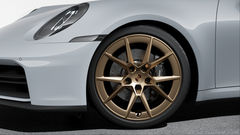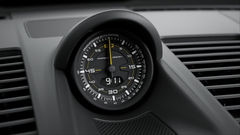
Porsche
VR Configurator
This was the project I've been involved in most consistently and ended up leading the art team for: a real-time configurator that allows users to customise their car at a dealership, feel them out in an immersive virtual reality environment, and order that exact model to be made for them in reality.
This configurator is exclusively running at dealerships, but I can provide a preview of its functionality:
When a new model released that Porsche wanted implemented into the configurator, my team and I would get a simple conversion of the CAD geometry. We would organise it into configurable layers, clean it up of any unnecessary data (internal technical parts, redundancies, helpers), rig all movable parts, and materialise it according to our library. Before the introduction of Nanite technology for Unreal, we also had to reduce high density geometry for performance.
Once the data was roughly organised, we could work on the configuration logic, which determined how exactly the car can be configured inside the application. In our proprietary software, we wrote logic statements for every switchable piece of geometry and material to slowly build up this logic. As reference, we received several documents from Porsche, which detailed the specifics of what's possible for each car and its potential special editons.
New models also came with new materials, like exclusive carpaints, fabrics, decors, or displays. While Porsche could provide some data, it was most often up to us to create the materials manually, based off a dedicated photoshoot. Over time, we built a material library of thousands of materials, all standardised in properties and naming.
Eventually, we would send a work-in-progress version to the customer and this is where most of our efforts went: feedback and maintenance. We spent a lot of time communicating with a Porsche representative on the behaviour of the configuration logic in edge cases, or the exact shade of a carpaint under different lighting conditions. Sometimes, this necessitated lengthy in-person meetings with a design expert, where we went over everything on a color-calibrated monitor. The complex interactive nature of the project also resulted in a lot of small bugs that needed to be patched weeks after a release.
I look back quite fondly on this project, because this is where I could see myself growing from a supporting junior role to overseeing every part of the process, as well as my own junior artists. Even when I had to work late for this project, I found it satisfying, to be relied on by everyone for a deadline, lock in for a few evenings, and successfully deliver.
Web Configurator
This is the more well-known configurator, because it is accessible in any web browser. Although my team and I were more focussed on the realtime VR configurator, we frequently assisted the web team in data preperation, material creation, and rendering.
While the process is generally similar (a lot of what I described there also applies here) the biggest difference between the VR and web configurator is the way it's rendered: while the VR configurator has to render everything in real-time, which necessitates performance considerations, the web configurator merely shows picture compositions, which can achieve far higher visual fidelity, but lack the interactive aspect.
Also unlike the VR configurator, you can check out the current version live: https://configurator.porsche.com

We also had a system in place that can render static promotional materials seperate from the configurator:

Driving Experience
As a companion function to the configurator, we developed a render-on-demand system, where once a car was processed for the VR configurator, we could render a promotional driving animation in just a few hours.
When I joined this sub-project, the environments were already prepared, but I perfected the lighting and postprocessing, worked the cameras, and made the changes necessary to accomodate all available Porsche models, which had entirely different shapes and sizes.
Detail Renderings

As part of both the VR and web configurator, Porsche requested that certain options come with detailed previews, to show exactly what they do when a user hovers over them.
For this purpose, I created a set of new camera and light levels to show off these details in proper composition and quality, beyond what would be possible in real-time, and our developers created a render pipeline that can automate the render process for every option and possible configuration.
A Porsche representative would send us a detailed table of requested cameras and car configurations, and our internal toolset would automatically construct the scenes and render thousands of pictures, ready to be deployed to the configurators.
Despite being automated, the system required a lot of granular oversight and manual fixes, which was my responsibility as well.






















